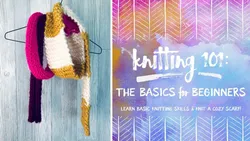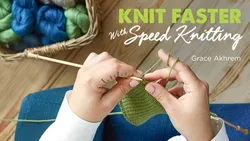
Knitting 101: The Basics for Beginners 
This course, Knitting 101: The Basics, is designed to teach you the fundamentals of knitting. You will learn how to cast on and off your needles, the knit and purl stitches, and how to weave in your ends. You will also get an overview of the different types of yarn, how to use a gauge swatch to customize your project, and how to switch colors or add more yarn. Step-by-step videos will guide you through each skill. By the end of the course, you will have knit a cozy scarf and have the basic knowledge to tackle any project you choose. ▼
ADVERTISEMENT
Course Feature
![]() Cost:
Cost:
Free Trial
![]() Provider:
Provider:
Skillshare
![]() Certificate:
Certificate:
Paid Certification
![]() Language:
Language:
English
![]() Start Date:
Start Date:
On-Demand
Course Overview
❗The content presented here is sourced directly from Skillshare platform. For comprehensive course details, including enrollment information, simply click on the 'Go to class' link on our website.
Updated in [May 25th, 2023]
Knitting 101: The Basics for Beginners is a course designed to teach the fundamentals of knitting. Students will learn how to cast yarn on and off their needles, the knit and purl stitches, and how to weave in their ends. Additionally, they will gain an understanding of the different types of yarn available, how to use a gauge swatch to customize their project, and how to switch colors or add more yarn. Step-by-step videos will be provided to demonstrate each skill. Upon completion of the course, students will have knit a cozy scarf and have the basic knowledge needed to tackle any project they choose.
[Applications]
After completing Knitting 101: The Basics, learners can apply their newfound knowledge to create a variety of projects. They can use the skills they have learned to create scarves, hats, sweaters, and other garments. Additionally, they can use the knowledge of different types of yarn and gauge swatches to customize their projects. With the skills they have acquired, learners can also move on to more advanced knitting projects.
[Career Paths]
1. Knitting Designer: A Knitting Designer is responsible for creating and designing knitting patterns for garments, accessories, and home decor items. They must have a good understanding of the knitting process and be able to create patterns that are both aesthetically pleasing and technically sound. The demand for Knitting Designers is increasing as more people are looking for unique and handmade items.
2. Knitting Instructor: A Knitting Instructor is responsible for teaching knitting classes and workshops. They must have a good understanding of the knitting process and be able to teach it to others in a clear and concise manner. The demand for Knitting Instructors is increasing as more people are looking to learn the craft.
3. Knitting Technician: A Knitting Technician is responsible for operating and maintaining knitting machines. They must have a good understanding of the knitting process and be able to troubleshoot any issues that may arise. The demand for Knitting Technicians is increasing as more companies are looking to automate their production processes.
4. Knitting Entrepreneur: A Knitting Entrepreneur is responsible for creating and selling their own knitting products. They must have a good understanding of the knitting process and be able to create products that are both aesthetically pleasing and technically sound. The demand for Knitting Entrepreneurs is increasing as more people are looking for unique and handmade items.
[Education Paths]
1. Bachelor of Science in Textile Design: This degree path focuses on the design and production of textiles, including knitting. Students learn about the history of textiles, the principles of design, and the technology used in the production of textiles. They also learn about the business aspects of the industry, such as marketing and pricing. This degree path is becoming increasingly popular as the demand for handmade and custom-made textiles grows.
2. Master of Science in Textile Engineering: This degree path focuses on the engineering aspects of textiles, such as the development of new materials and processes. Students learn about the science behind textiles, including the physics and chemistry of fibers and fabrics. They also learn about the design and production of textiles, as well as the business aspects of the industry. This degree path is becoming increasingly popular as the demand for innovative and sustainable textiles grows.
3. Bachelor of Arts in Fashion Design: This degree path focuses on the design and production of clothing and accessories. Students learn about the history of fashion, the principles of design, and the technology used in the production of clothing and accessories. They also learn about the business aspects of the industry, such as marketing and pricing. This degree path is becoming increasingly popular as the demand for unique and custom-made fashion items grows.
4. Master of Arts in Textile Management: This degree path focuses on the management aspects of textiles, such as the development of new materials and processes. Students learn about the science behind textiles, including the physics and chemistry of fibers and fabrics. They also learn about the design and production of textiles, as well as the business aspects of the industry. This degree path is becoming increasingly popular as the demand for efficient and sustainable textiles grows.
Pros & Cons

Best knitting class ever

Easy to see

Solid basis

None mentioned
Course Provider

Provider Skillshare's Stats at AZClass
Discussion and Reviews
0.0 (Based on 0 reviews)
Explore Similar Online Courses

Textures in Adobe Illustrator: Surface Pattern Design for Beginners

Equalization in the audio mix: learn how to EQ effectively

Python for Informatics: Exploring Information

Social Network Analysis

Introduction to Systematic Review and Meta-Analysis

The Analytics Edge

DCO042 - Python For Informatics

Causal Diagrams: Draw Your Assumptions Before Your Conclusions

Whole genome sequencing of bacterial genomes - tools and applications

Special Techniques for Machine Knitting: Color & Texture

Speed Knitting With Combined Continental


Start your review of Knitting 101: The Basics for Beginners